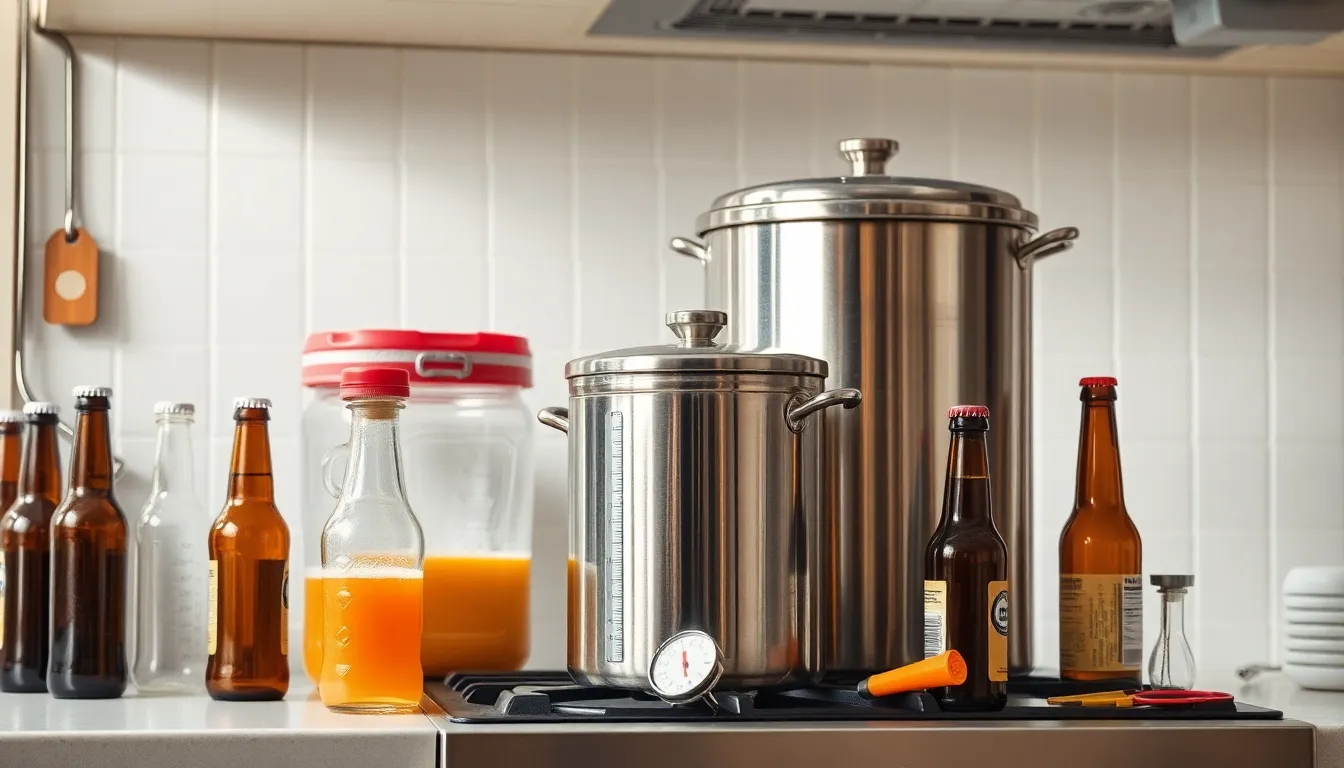Table of Contents
ToggleImagine sipping a cold brew crafted right in your own kitchen, the aroma of hops wafting through the air. Making beer at home isn’t just a hobby; it’s a rite of passage for many aspiring brewmasters. With a little patience and the right ingredients, anyone can transform their kitchen into a mini brewery.
Ingredients Needed
Home brewing requires specific ingredients to achieve desired flavors and aromas. Each component plays a crucial role in the brewing process, ensuring a successful outcome for homemade beer.
Malted Barley
Malted barley serves as the primary source of fermentable sugars. This ingredient provides sweetness and color to the beer. Various types of malt contribute unique flavors. Pale malt delivers a light, crisp taste while caramel malt adds a hint of toffee or caramel notes. Brewers often combine different malts to create balanced profiles. Typical usage ranges from 6 to 12 pounds of malted barley per five-gallon batch.
Hops
Hops add bitterness, flavor, and aroma to beer, balancing the sweetness of the malt. Various hop varieties exist, each offering unique characteristics. For instance, Cascade hops impart floral citrus tones, while Saaz hops introduce a spicy herbal quality. Brews typically include hops added at different stages: bittering hops during the boil, and aroma hops close to the end. A general guideline suggests using 1 to 3 ounces of hops per five-gallon batch.
Yeast
Yeast is essential for fermentation, transforming sugars from malt into alcohol and carbon dioxide. Different strains of yeast produce various flavors and aromas. Ale yeast thrives at warmer temperatures, yielding fruity and complex beers. In contrast, lager yeast ferments cooler and creates clean, crisp styles. Each brew benefits from selecting the right yeast strain. Generally, one packet of yeast suffices for a five-gallon batch.
Water
Water accounts for the largest portion of beer, so its quality influences the final product significantly. The mineral content affects flavor, mouthfeel, and overall profile. Municipal waters may require adjustments to meet specific brewing needs, such as adding calcium for better yeast health. Brewers often aim for balanced mineral content, which includes sulfates and chlorides. Roughly 6 gallons of water is typical for producing five gallons of finished beer.
Equipment Required

Home brewing requires specific equipment to ensure a successful and enjoyable process. The right tools help simplify each stage of brewing, from boiling to fermentation and bottling.
Brewing Kettle
A brewing kettle is essential for boiling the wort, which combines the malt extract and hops. Stainless steel or aluminum kettles provide an even heating surface to prevent scorching. Kettles typically range from 3 gallons to 10 gallons, allowing for different batch sizes. A lid helps retain heat and moisture during boiling. Ventilation is crucial to dissipate steam while brewing. A thermometer accurately measures temperature, while a sight glass offers visibility into the liquid level for monitoring.
Fermenter
The fermenter holds the wort after boiling, allowing yeast to convert sugars into alcohol. Plastic fermenters are lightweight and easy to handle, while glass carboys resist scratches and offer a clear view. Both options should have an airlock to release carbon dioxide during fermentation while preventing outside contamination. Keeping fermentation temperature controlled is important for desirable flavors. Fermentation typically lasts from one to two weeks, depending on the desired beer profile.
Bottling Equipment
Bottling equipment includes bottles, caps, and a capper. Standard 12-ounce glass bottles are commonly used, with larger options available for different servings. A bottle brush ensures proper cleaning and sanitization before use. The capper secures caps onto bottles, maintaining freshness and carbonation. Priming sugar is often added before capping to promote carbonation within the bottles. A bottling wand simplifies the filling process, minimizing spills and oxidation.
Brewing Process
The brewing process involves several key steps to transform ingredients into beer.
Sanitizing
Sanitizing equipment is essential to prevent contamination. All tools and containers must be cleaned with a sanitizing solution before use. Star San or iodine-based sanitizers are popular choices among home brewers. Ensuring cleanliness protects the flavor and quality of the final product. Rinsing equipment with clean water after sanitizing helps remove excess residue.
Brewing the Wort
Brewing the wort starts by heating water in a kettle. Adding malted barley and boiling for about 60 minutes extracts sugars. Hops are introduced during the boil for bitterness and aroma, with timing affecting the flavor profile. Stirring occasionally maintains an even temperature and prevents scorching. After boiling, the wort must be filtered to remove solid grains, creating a sweet liquid for fermentation.
Cooling the Wort
Cooling the wort quickly is crucial to minimize bacterial growth. Immediatelty after boiling, brewers use immersion or counterflow chillers to achieve the ideal temperature. Cooling to around 70°F allows yeast to thrive during fermentation. Monitoring temperature during this step ensures proper yeast activity. Placing the cooled wort into a sanitized fermenter sets the stage for fermentation.
Fermentation
Fermentation begins once yeast is added to the cooled wort. Different yeast strains lead to varying flavor profiles in the beer. During the fermentation period, which can last from a few days to several weeks, the yeast converts sugars into alcohol and carbon dioxide. Observing airlock activity indicates active fermentation. After fermentation completes, the beer is ready for conditioning and bottling.
Bottling and Aging
Bottling and aging transform beer into a finished product, ready for enjoyment. Proper preparation during this stage ensures quality and flavor retention.
Preparing for Bottling
Sanitization plays a vital role in preparing for bottling. Clean bottles, caps, and bottling equipment with a sanitizer like Star San to eliminate any potential contaminants. Check for any residual odors or residues in bottles. Gather the right tools, including a bottling wand, to facilitate the process efficiently. Prepare priming sugar to carbonate the beer, using about 3/4 cup of corn sugar for a 5-gallon batch. Dissolve the sugar in boiling water, cool it, and then mix it with the beer before bottling to achieve the desired carbonation level.
Bottling the Beer
Bottling begins after fermentation completes. Transfer the beer into a bottling bucket, ensuring minimal exposure to oxygen. Fill each bottle, leaving about an inch of headspace. Use a bottling wand to ease filling and minimize mess, which allows for consistent flow. Insert caps securely on each bottle, ensuring they are tight to prevent oxidation. Store bottles upright in a cool, dark place to allow carbonation to develop.
Aging Your Beer
Aging enhances the flavors of beer, providing depth and complexity. Allow ales to age for at least two weeks, while lagers benefit from longer aging, up to six weeks. Monitor temperatures, as cooler conditions generally produce better results. Try tasting the beer periodically, noting how flavors evolve over time. Package notes can help track preferences and ideal aging durations. Once ready, store the finished product in a cool, dark area for optimal taste when the time comes to enjoy the brew.
Home brewing offers an exciting opportunity for anyone looking to explore the art of beer making. With the right ingredients and equipment anyone can craft unique flavors right in their kitchen. The process may seem intricate but each step contributes to the final product’s character.
As brewers gain experience they’ll discover their personal preferences and techniques. This journey not only fosters creativity but also builds a deeper appreciation for the craft. Whether sharing with friends or enjoying a personal creation home brewing can be a fulfilling and enjoyable hobby. So gather those ingredients and start brewing; a world of flavors awaits.




